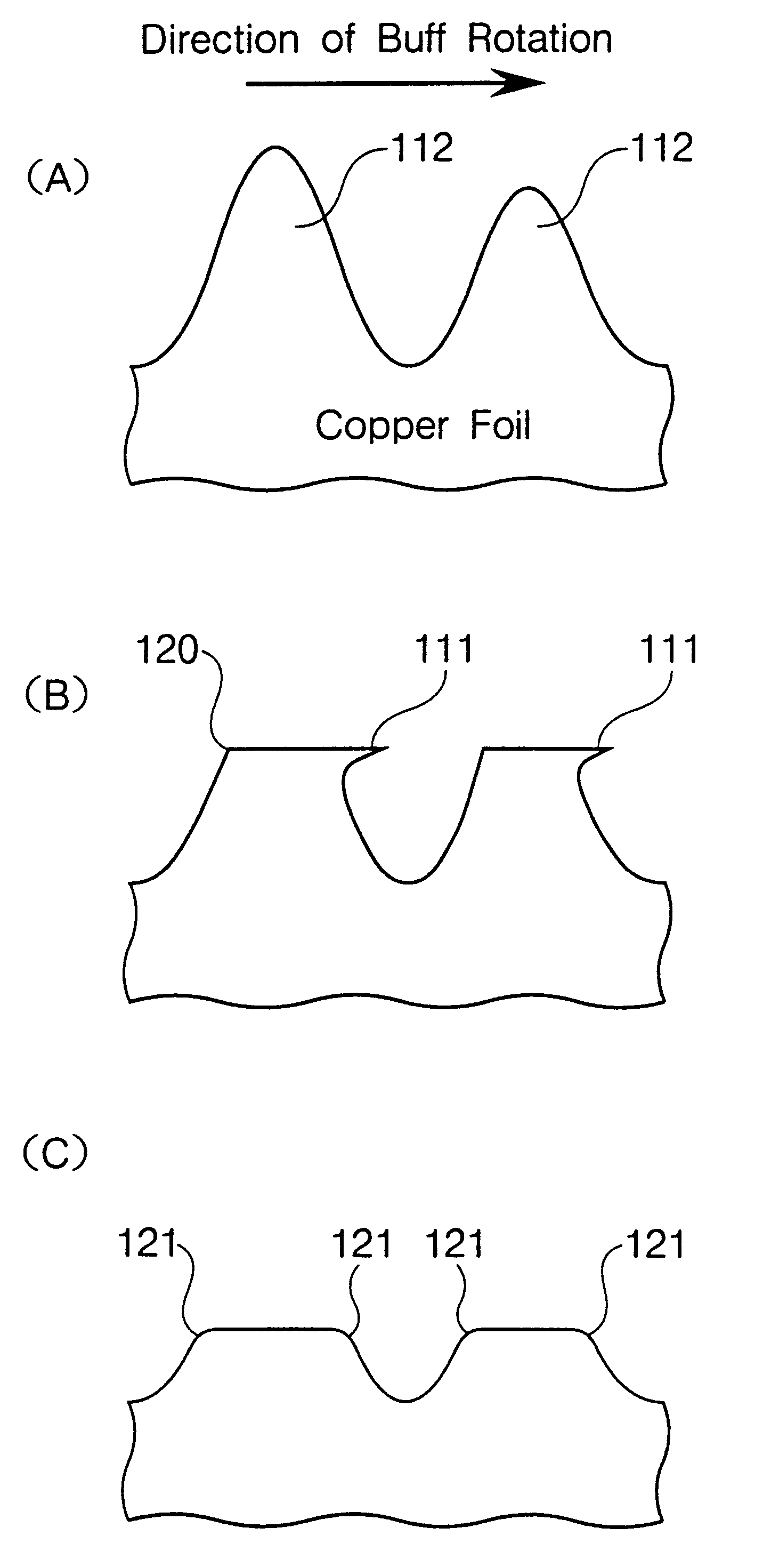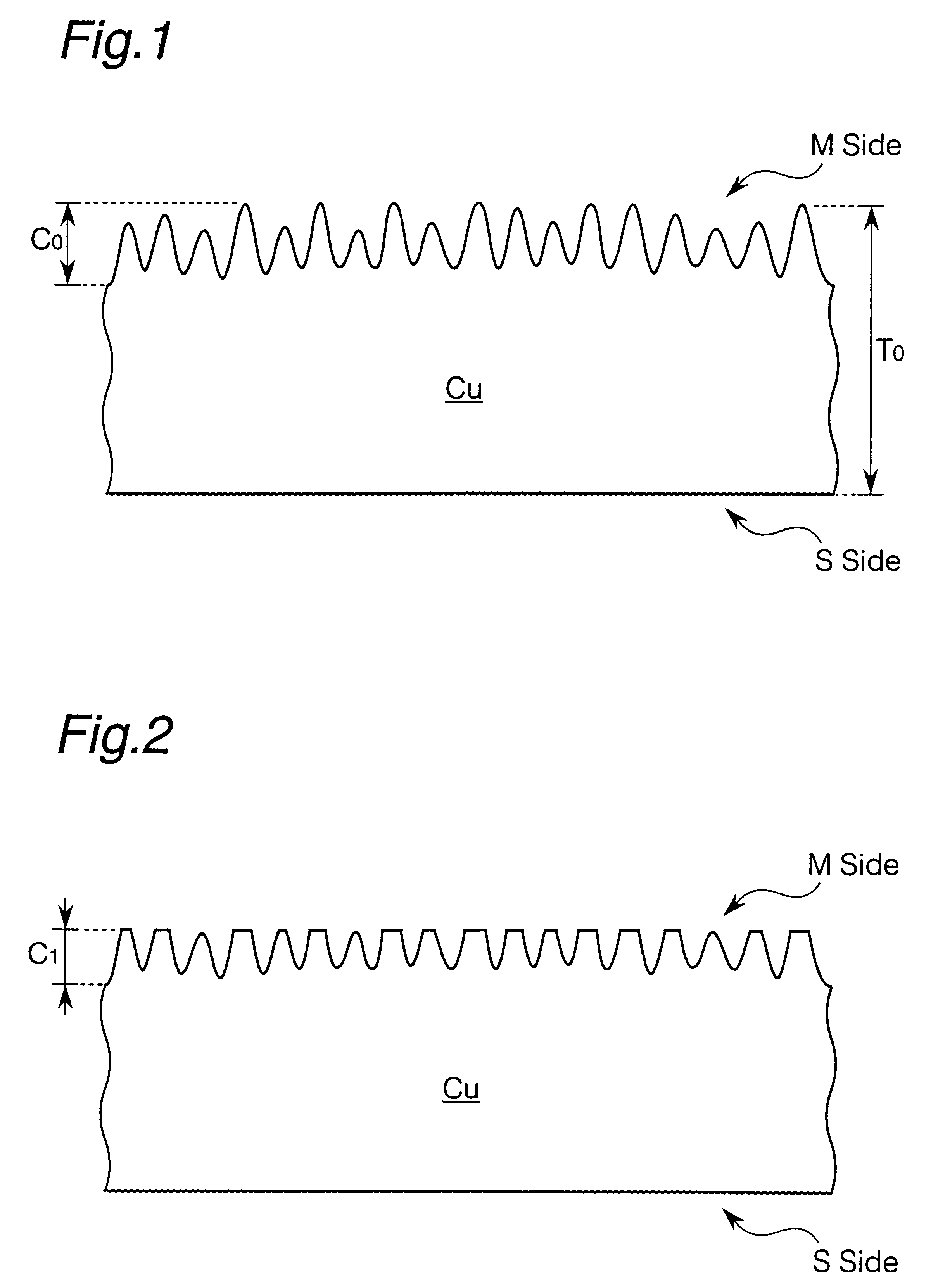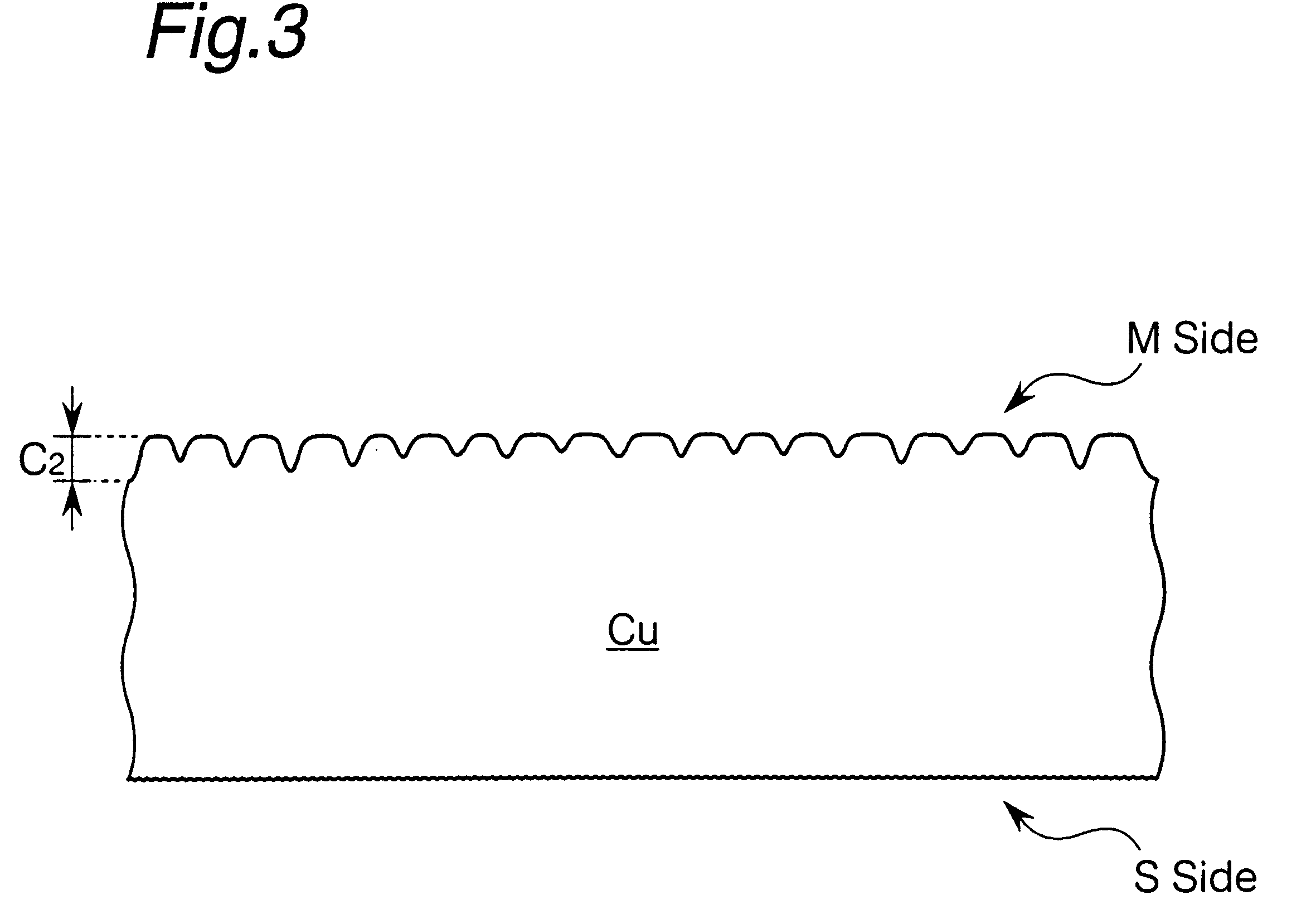The electrodeposited copper foil with its surface prepared according to the present invention is obtained by sequentially subjecting the matte side to the mechanical polishing and the chemical polishing. The mechanical polishing mainly polishes apex portions of the protrudent parts of the matte side, and the subsequent chemical polishing further uniformly eliminates shelf-shape deformation on the mechanically polished matte side. In the electrodeposited copper foil with its surface prepared according to the present invention, obtained by sequentially subjecting the matte side to the mechanical polishing and the chemical polishing, mechanical polishing traces formed along the mechanical polishing direction and strain layers, generated by the mechanical polishing operation, are eliminated by the chemical polishing to thereby enable forming a strikingly uniform matte side surface. Treating for roughening the thus prepared matte side of the electrodeposited copper foil with its surface prepared enables uniformly forming fine particles of copper on the matte side (electrodeposited copper foil with its surface prepared and treated). The PWB obtained by laminating, for example, an insulating substrate with the thus obtained electrodeposited copper foil with its surface prepared according to the present invention and forming the copper foil into a wiring pattern exhibits a high peel strength between the wiring pattern and the insulating substrate and further ensures an overall stable strength. Moreover, in the process of the present invention, not only are apex portions of the protrudent parts of the matte side mainly mechanically polished but also the polishing irregularity, streaks, strain, etc., resulting from the mechanical polishing, are eliminated by the chemical polishing. Thus, the copper loss by polishing is strikingly slight, and the matte side surface consisting of a continuous curved shape can be obtained.
This roughening treatment of the matte side enables performing uniform nodulating treatment of the prepared matte side. Thus, PWB capable of exhibiting high performance in adhesive strength, bonding reliability, etc. can be obtained.
In the process of the present invention, the matte side of the electrodeposited copper foil is sequentially subjected to the mechanical polishing performed under mild conditions and the chemical polishing, so that the occurrence of streaks and the like on the polished matte side can be suppressed. The streaks are generally attributed to excess polishing, and the electrodeposited copper foil of this part is thinner there than at other parts. Thus, when the electrodeposited copper foil having streaks is employed in the use of an extremely thin copper foil in accordance with the trend toward fine pitch, the mechanical strength of wiring pattern there is reduced with the result that the streak portions are likely to become the cause of failure such as open circuit. The electrodeposited copper foil with its surface prepared, produced by the process of the present invention, is free from such streaks attributed to excess polishing, so that, with respect to wiring boards such as PWB produced with the use of the prepared electrodeposited copper foil, the occurrence of defective items attributed to such an open circuit or the like is strikingly low.
Moreover, when the electrodeposited copper foil with its surface prepared according to the present invention is formed into a wiring pattern through superimposing the same on an insulating substrate by laminating or bonding after resist application and etching, the difference between upper edge width and lower edge width of the formed wiring (especially lead parts) is minute. Thus, a wiring of approximately rectangular cross section can be formed. In the use of the conventional electrodeposited copper foil, the lower edge tends to be larger and wavier than the upper edge in the formed wiring, thereby causing the cross section configuration to be trapezoidal. However, in the use of the electrodeposited copper foil with its surface prepared according to the present invention, the above trend is eliminated, and a wiring of approximately rectangular cross section can be obtained. Furthermore, the lower edge portions of the wiring are etched linearly, and there is substantially no copper residue on the insulating substrate. These characteristics, although important in, for example, inner leads as well, are especially important in output side outer leads electrically connected to liquid crystal elements, and the like. With respect to the output side outer leads electrically connected to liquid crystal elements, a plurality thereof are connected to liquid crystal pixels, and not only is the lead width thereof extremely small but also the pitch is rendered small. Accordingly, the output side outer leads are likely to suffer from insulation failure between neighboring leads. For example, even if the linearity of output side outer leads is slightly deteriorated, there is the danger of insulation failure (short circuit). Further, if the lower edge is slightly wider than the upper edge in the output side outer leads, there is the danger of insulation failure (short circuit) on the surface of the insulating substrate. Still further, even if slight copper residue exists on the insulating substrate, there is the danger of insulation failure (short circuit). In the output side outer lead parts of PWBs (especially TAB tape) connected to liquid crystal elements, etching of the copper foil must be achieved with precision equal to or higher than that for inner leads for mounting electronic components. Especially, with respect to the output side outer leads of the TAB tape for liquid crystal elements, these must be formed on an insulating substrate by etching the electrodeposited copper foil disposed on the insulating substrate by laminating, so that each of the leads is likely to have a trapezoidal cross section as compared with inner leads which extend out into device holes and under which any insulating substrate is not present. Further, due to the presence of the insulating substrate, copper residue is likely to occur. Therefore, it is believed that the achievement of fine pitch is more difficult in the output side outer leads than in the inner leads.
However, the above achievement of fine pitch in the output side outer leads can be enabled by the use of the electrodeposited copper foil with its surface prepared according to the present invention. Specifically, by virtue of the use of the electrodeposited copper foil with its surface prepared according to the present invention, not only do the output side outer leads formed by etching have a rectangular cross section (upper edge width being substantially the same as the lower edge width) but also the linearity of formed leads is high. Further, there is no copper residue on the surface of the insulating substrate. Although the particular reason for the above excellent etching properties of the electrodeposited copper foil with its surface prepared according to the present invention has not yet been elucidated, specific exertion of the above effects of the present invention would be achieved by the mechanical polishing followed by the chemical polishing.
As apparent from the above, the electrodeposited copper foil with its surface prepared, obtained by the process of the present invention, ensures not only high adherence to insulating substrates but also strikingly high yield of device mounting on boards.
 Login to View More
Login to View More 


